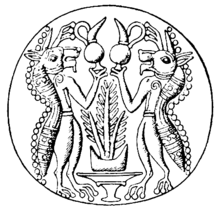Minoan Genius
The Minoan Genius is a fantastic mythological creature that was common in ancient Crete. It is portrayed sometimes with the head of a lion, or of hippopotamus, or of other animals. It played a role in various religious ceremonies.

It is often portrayed with water vessels, such as ewers, so it seems to play a role as libation bearer.
Mythological connections
The connections of this mythological beast seem to be with the griffin—a very widespread composite mythological beast—as well as with the Egyptian hippopotamus and crocodile goddess Taweret, from which it is believed to have derived.
According to Judith Weingarten, the earliest forms of the Minoan Genius derived from the Egyptian prototypes between approximately 1800 and 1700 BC.[1]
Later on, the Genius also became a deity in the Mycenaean world; its representations are found widely in continental Greece.[2]
See also
Notes
- Weingarten, J. 1991. The Transformation of Egyptian Taweret into the Minoan Genius: A Study in Cultural Transmission in the Middle Bronze Age. Partille, Paul Åström Förlag.
- P. Rehak, The ‘Genius’ in Late Bronze Age Glyptic: the Later Evolution of an Aegean Cult Figure (PDF file), in W. Müller (ed.), Sceaux Minoens et Mycéniens [CMS Beiheft 5] (Berlin 1995) 215-231
Bibliography
- C. Baurain, “Pour une autre interprétation des génies minoens,” in P. Darcque and J-C. Poursat (eds.), L’iconographie minoenne [BCH Supplement 11] (Paris 1985) 95-118.
- M. Benzi, “Minoan Genius on a LH III Pictorial Sherd from Phylakopi, Melos? Some Remarks on Religious and Ceremonial Scenes on Mycenaean Pictorial Pottery,” Pasiphae 3(2009) 9-26.
- Gill. M. A. V. 1961. The Minoan Genius: An Iconographical Study. Unpublished PhD thesis, University of Birmingham.
- Gill. M. A. V. 1964. The Minoan Genius. Mitteilungen des Deutschen Archäologischen Instituts, Athenische Abteilung 79, 1-21.
- P. Rehak, The ‘Genius’ in Late Bronze Age Glyptic: the Later Evolution of an Aegean Cult Figure (PDF file), in W. Müller (ed.), Sceaux Minoens et Mycéniens [CMS Beiheft 5] (Berlin 1995) 215-231
- C. Sambin, “Génie minoen et génie egyptien, un emprunt raisonné,” BCH 113(1989) 77-96.
- Weingarten, J. 1991. The Transformation of Egyptian Taweret into the Minoan Genius: A Study in Cultural Transmission in the Middle Bronze Age. Partille, Paul Åström Förlag.
- Weingarten J. and Hallager, E. 1993. The Five Roundels from Malia, and a Note on Two New Minoan Genii. Bulletin de correspondance hellénique 117, 1-18.
- J. Weingarten, 2013, The Arrival of Egyptian Taweret and Beset on Minoan Crete: Contact and Choice, in L. Bombardieri, A. D’Agostino, G. Guarducci, V. Orsi, S. Valentini (eds), SOMA 2012, Identity and Connectivity, Proceedings of the 16th Symposium on Mediterranean Archaeology, Florence, Italy, 1–3 March 2012, Vol..I, Bar International Series 2581 (I) 2013, 371-378.
Further reading
- Delplace, Christiane. "Le griffon créto-mycénien". In: L'antiquité classique, Tome 36, fasc. 1, 1967. pp. 49-86. DOI: https://doi.org/10.3406/antiq.1967.2644 ; www.persee.fr/doc/antiq_0770-2817_1967_num_36_1_2644